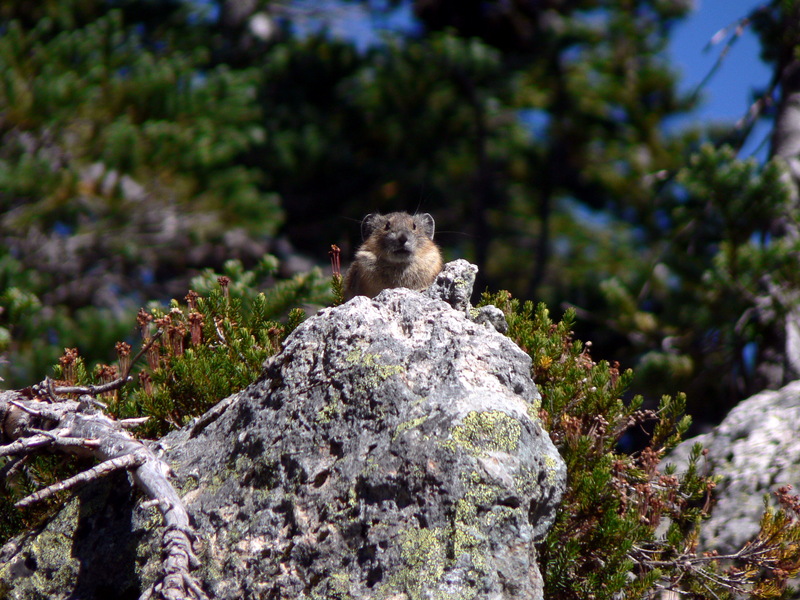| 새로운 사진 | 신문속의 동물소식 | 신기한 동물이야기 | 동물의 소리 | 동물동화상 | 사진 올리기 | 사진 저작권 | English |
|---|
| 재미있는 동물사진 | 괴수/괴어/엽기 동물사진 | 동물이름사전 | 동물목록 | 바깥고리 | 창고입구 | 똑똑누리집 |
|---|
| 이미지 정보 | Original File Name: American Pika, Ochotona princeps taylori_26473.jpg Resolution: 2560x1920 File Size: 1872518 Bytes Date: 2007:09:26 14:18:10 Camera: DMC-FZ5 (Panasonic) F number: f/2.8 Exposure: 10/10000 sec Focal Length: 720/10 Upload Time: 2008:01:08 09:58:26 | |
| 올린이 | 이름 (메일주소): Unknown | |
| 사진 제목 | Pika (Family: Ochotonidae) - Wiki | |
 |
| Email : 카드 | 올린이 | 운영자 사진삭제 정보수정 Admin |
| 설명 | Pika (Family: Ochotonidae) - Wiki
Pika
The name pika (archaically spelled pica) is used for any member of the Ochotonidae, a family within the order of lagomorphs, which also includes the Leporidae (rabbits and hares). One genus, Ochotona, is recognised within the family, and it includes 30 species. Pikas are also called rock rabbits or coneys. It is also known as the "whistling hare" due to its high-pitched alarm call when diving into its burrow. The pika may look like a hamster, but is actually a cousin of the rabbit. The name "pika" appears to be derived from the Tungus "piika", or perhaps from the Russian "pikat", to squeak. In the United States the pronunciation of the name is usually altered from /pika/ to /'p????·ka/, probably due to the spelling. Habitat Pikas are native to cold climates, mostly in Asia, North America and parts of eastern Europe. Most species live on rocky mountain sides, where there are numerous crevices to shelter in, although some also construct crude burrows. A few burrowing species are instead native to open steppe land. In the mountains of Eurasia, pikas often share their burrows with snowfinches, which build their nests there. In a January 2006 article in the Journal of Biogeography, archeologist Donald Grayson warned that human activity and global climate change appeared to be pushing the American pika population to ever-higher elevations and thus possibly toward extinction. Grayson studied pika habitation over the past 40,000 years in the region between the Sierra Nevada (U.S.) and Rocky Mountains. An earlier Journal of Mammalogy article reached a similar conclusion. Characteristics Pikas are small hamster-like animals, with short limbs, rounded ears, and short tails. They are about 18-20 cm in body length, with a tail less than 2 cm long, and weigh between 75 and 290 grams, depending on species. Like rabbits, after eating they initially produce soft green feces, which they eat again to extract further nutrition, before producing the final, solid, fecal pellets. These animals are herbivores, and feed on a wide variety of plant matter. Because of their native habitat, they primarily eat grasses, sedges, shrub twigs, moss, and lichen. As with other lagomorphs, pikas have gnawing incisors and no canines, although they have fewer premolars than rabbits, giving them a dental formula of: 2.0.3.2 1.0.2.3 Rock-dwelling pikas have small litters of less than five young, while the burrowing species tend to give birth to more young, and to breed more frequently, possibly due to a greater availability of resources in their native habitats. The young are born after a gestation period of between 25 and 30 days. Activity Pikas are diurnal or crepuscular, with higher altitude species generally being more active during the daytime. They show their peak activity before the winter season. Pikas do not hibernate, so they rely on collected hay for warm bedding and food. Pikas gather fresh grasses and lay them in stacks to dry. Once the grasses dry out, the pikas take this hay back to the burrows for storage. It is not uncommon for pikas to steal hay from others; the resulting disputes are usually exploited by neighboring predators like ferrets and large birds. Eurasian pikas commonly live in family groups and share duties of gathering food and keeping watch. At least some species are territorial. North American pikas (Ochotona princeps and Ochotona collaris) are asocial, leading solitary lives outside the breeding season. Species ORDER LAGOMORPHA Family Ochotonidae: pikas Genus Ochotona Subgenus Pika: northern pikas - Alpine Pika/Altai Pika, Ochotona alpina - Silver Pika, Ochotona argentata - Collared Pika, Ochotona collaris - Hoffmann's Pika, Ochotona hoffmanni - Northern Pika/Siberian Pika, Ochotona hyperborea - Pallas's Pika, Ochotona pallasi - American Pika, Ochotona princeps - Turuchan Pika, Ochotona turuchanensis Subgenus Ochotona: shrub-steppe pikas - Gansu Pika/Gray Pika, Ochotona cansus - Plateau Pika/Black-lipped Pika, Ochotona curzoniae - Daurian Pika, Ochotona dauurica - Tsing-ling Pika, Ochotona huangensis - Nubra Pika, Ochotona nubrica - Steppe Pika, Ochotona pusilla - Afghan Pika, Ochotona rufescens - Moupin Pika, Ochotona thibetana - Thomas's Pika, Ochotona thomasi Subgenus Conothoa: mountain pikas - Chinese Red Pika, Ochotona erythrotis - Forrest's Pika, Ochotona forresti - Gaoligong Pika, Ochotona gaoligongensis - Glover's Pika, Ochotona gloveri - Himalayan Pika, Ochotona himalayana - Ili Pika, Ochotona iliensis - Kozlov's Pika, Ochotona koslowi - Ladak Pika, Ochotona ladacensis - Large-eared Pika, Ochotona macrotis - Muli Pika, Ochotona muliensis - Black Pika, Ochotona nigritia - Royle's Pika, Ochotona roylei - Turkestan Red Pika, Ochotona rutila http://en.wikipedia.org/wiki/Pika
| |||
| 저작권 정보 | 사진의 저작권은 원저작자에게 있습니다. 동물그림창고는 동물관련 사진을 전시할 수 있는 공간만을 제공합니다.사진을 사용하고자 할 경우에는 저작권자와 협의하시기 바랍니다. |
|
|
|
| |||||||
| CopyLeft © since 1995, 동물그림창고. All rights may be reserved. | ||||||||
Stats